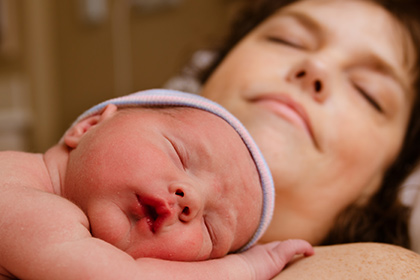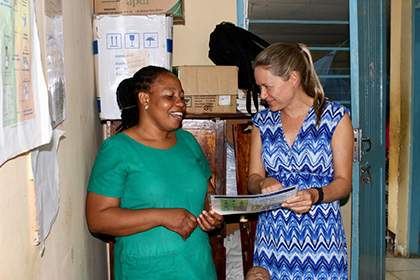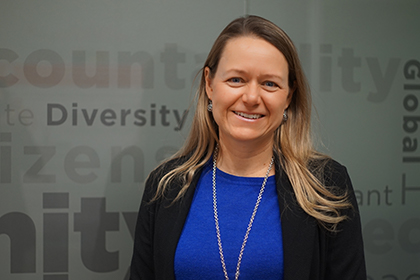Global lessons in mother and child health


Skin-to-skin care is the placing of newborns on their mothers’ bare chests immediately after and in the days following birth.
Most mothers appreciate that parenting tips can come from many people, be it grandparents, friends or even total strangers who suggest, support and occasionally scold their child-care efforts. Dr. Jenn Brenner, who works in global maternal and child health, is aware that this exchange of advice can range pretty far.
The pediatrician is a clinical associate professor at the University of Calgary’s Cumming School of Medicine as well as director of the faculty’s global maternal, newborn and child initiatives. This gives her a unique perspective on what high-income countries like Canada can offer as well as learn from low-income ones.
“Global health programs often involve the transfer of ideas and resources from rich countries to poor,” says Brenner. “But there’s also a great opportunity for the opposite to happen.”
She sees a perfect example of this “reverse innovation” with skin-to-skin care, the placing of newborns on their mothers’ bare chests immediately after and in the days following birth. This technique helps children “grow earlier and go home earlier,” Brenner says, “especially premature babies, compared with the gold standard previously of spending 24 hours in the incubator.” Skin-to-skin originated in Colombia in the 1970s “out of necessity,” she explains. “There were no incubators and electricity was scarce.”
Today, she notes, skin-to-skin is used in nurseries across Canada. “It is accepted as a best-care practice for all newborns, whether premature or at term.”
Brenner says Canada in turn has contributed much to global maternal and child health, part of a concerted effort to improve child survival throughout the world. When she first began pediatric training in the mid-1990s, more than 12 million children a year died before reaching their fifth birthday. Today, it’s less than half that number—at 5 million deaths a year. While this “is still too high,” she says, the trend is encouraging. “In global pediatrics, we’re now talking about not just surviving, but also thriving.”
Early in her career, Brenner trained and did clinical work in countries such as India and Uganda, learning especially about their community health concepts. More recently, she has headed up her university’s longstanding maternal, newborn and child health partnerships—supported by 抖淫视频—with universities in East Africa. These massive team efforts include (Mother and Child) in Tanzania and , which has begun a new project to support adolescent health needs, including addressing issues emerging from the COVID-19 pandemic.
A stark dichotomy
Brenner’s international work has taken her from the brand-new Alberta Children’s Hospital, “a state-of-the-art, highly technical facility—one of the best in the world,” to facilities in East Africa, “crumbling buildings with no electricity and often no running water, managing equally sick children, but often without the essential medications and supplies that are needed.”

Dr. Jenn Brenner learns about best practices in newborn resuscitation from a colleague at a health facility in Mwanza, Tanzania. Photo: Ashley Anderson
It’s a “stark dichotomy that’s hard on the senses,” she says. At the same time, “I’ve been personally humbled, inspired and enlightened by so many of the people that I’ve worked with internationally, especially those who have very little, whether it’s health providers, communities, families or children,” she notes. “I’m increasingly aware of what our Canadian health system could learn if we were able to look and think more carefully about these low-resource settings and the experiences they have. Particularly countries that have much less than we do.”
But she’s found that Canadians are sometimes resistant to low-tech solutions that come from these countries. For instance, when she first worked abroad in India and Uganda, she saw first-hand the effectiveness of oral rehydration therapy in helping patients recover from dehydration caused by diarrhea. The therapy, which involves a solution of sugar, salt and water given slowly and continuously by mouth, was developed in the late 1970s in Bangladesh, which lacked more expensive and complex intravenous therapies.
“Oral-rehydration therapy might be one of the most remarkable stories of medicine in the 20th century,” comments Brenner. Some 5 million people a year, mostly children, had previously died each year from diarrhea. With the new treatment, “survival skyrocketed.”
Back in Calgary, she encouraged the use of oral rehydration, pointing out that it was easier, required fewer needle-pokes and meant that patients could go home more quickly. Sometimes, fellow practitioners and parents were hesitant. “They equated high-tech intravenous therapy to a higher standard of care,” she says. Today, the use of oral rehydration has increased at her hospital and others in Canada, with a number of studies demonstrating its benefits.
More is not always better
“We need to be willing to try less sophisticated and more simple options,” Brenner says. “Despite the fact that we have an abundance of tests and treatments and technology, more is not always better.”
Today Brenner is very aware of the continuing challenges of the COVID-19 crisis for everyone. Indeed, as a mother, she has juggled her own work with the schooling of her son at home.

Dr. Jenn Brenner works in global maternal and child health. Photo: Melanie Yar Khan
At the same time, she feels the pandemic has brought some “silver linings.” For example, it’s expedited the transition to new virtual platforms and practices such as remote medical appointments, which are a “big convenience” for busy parents. She hopes some routine health matters will continue to be handled online in the future.
Brenner notes that travel restrictions have also fostered “a new way of doing business” with global health partners. For instance, international experts in maternal and child health can more easily add their voices to discussions virtually. And in-country team members in Africa have managed well the technical elements of projects that “Canadians have previously travelled in for,” Brenner points out. She says that “it’s important that we retain” the practice of encouraging technical expertise to be developed abroad.
Shifting tasks to the community
A major part of the health programming work that Brenner has been involved with in Tanzania and Uganda has involved mobilizing volunteer community health workers, or CHWs. These are mostly women—indeed, many of them are mothers, Brenner points out—who are trained to assess sick children, administer immunizations and give medicines for simple childhood illnesses, among other tasks.
With support in part from 抖淫视频, fleets of CHWs equipped with mobile technologies have been engaged to raise awareness of COVID-19 and prevention measures to fight its spread, says Brenner. She thinks there’s a place for such health volunteers here at home. “Where we once relied on grandmothers, neighbours and elders for child-related advice, today there’s an opportunity for us to tap into the expertise of these wise community members.”
The CHWs in Healthy Child Uganda are now involved in an adolescent health initiative in the country’s southern districts called Healthy Adolescents and Young People (HAY!). Brenner says the project supports health service and promotion needs for youths aged 10 to 24 who are “under-represented in the health system.” HAY! will also address the extra burden young people face due to the COVID-19 crisis. There’s a concern that pandemic restrictions have resulted in increased teenage pregnancies and risk-taking behaviours, she notes, as well as declining mental and emotional health.
“A real priority is getting youth and families back on track. We need to normalize things as quickly as possible,” she says. “The whole world needs a reset.”
Meanwhile, Brenner feels the crisis is helping to “reframe the idea of global health.” She hopes a more global outlook will enhance how medicine is practiced and delivered in the future, with improved understanding of how disease travels.
“The pandemic has really created a convincing argument that it’s worthwhile to invest in managing health and health systems, not only here in Canada but around the world. Because we recognize that the health of one population really affects another,” she adds. “We can’t just continue to live in our small country bubbles anymore.”
- Date modified: